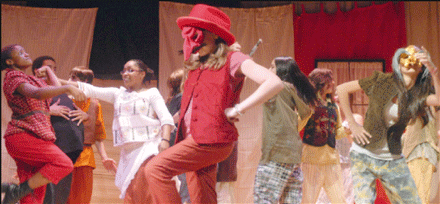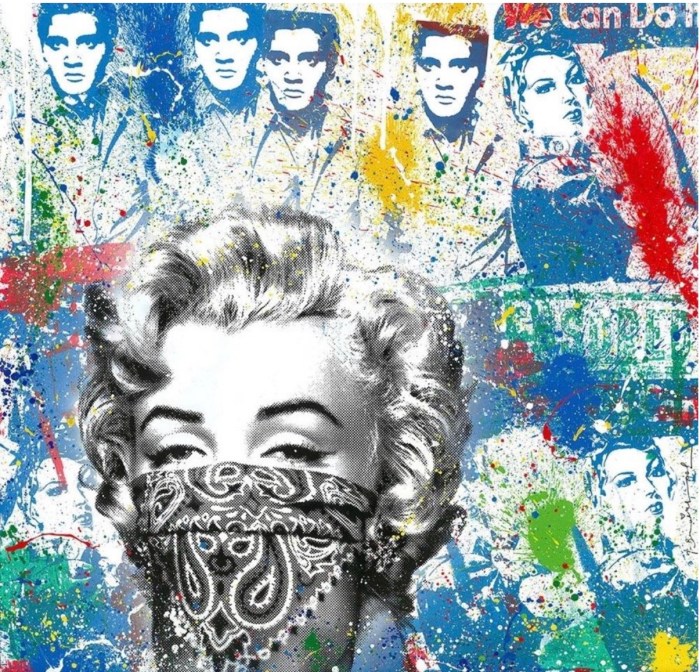By Jennifer Milne
In the darkened auditorium of I.S. 89 last week, a starving vagabond named Arlecchino slowly dragged himself across the stage. He was wearing a bright turquoise papier-mâché mask, part of the Italian Commedia dell’arte theater style, as he begged an innkeeper, Brighella, for a place to stay and some food.
“I’m so hungry, I could eat a horse,” Arlecchino said.
Brighella looked down at the vagabond matter-of-factly and replied, “You’re too late. I ate the horse last week!”
And so began “Fast Asleep,” one of four Commedia dell’arte plays in “Masked Madness,” a show written and directed by Theseus Roche, Manhattan Youth’s after school theater director. Commedia dell’arte, says Roche, is a style of theater that relies heavily on improvisation and stock characters – like Arlecchino and Brighella – that come from ancient Latin and Greek drama.
The kids were each “assigned” a character that came with an existing way of acting and being, according to the Italian theater tradition.
“In this play, [Roche] gave us an already set character, but we had the most freedom to play around with it,” said Paige Tendler, a seventh grader who played the Capitan. “We created our own people, they were our own characters. Since there was a pre-set way of being him [the Capitan], it gives you more time to focus on his special walk and special voice.”
“Masked Madness” was the Manhattan Youth Players’ eighth show since its inception, and seventh with Roche as director. Immediately following the close of the Players’ performance of “Richard III” on Feb. 10, Roche began working with 31 kids – all of which have lead roles in “Madness” – and writing the four short plays.
“We started working on the style [Commedia dell’arte] in February,” Roche said. “I based a lot of the script on what was happening in rehearsal and tried to tighten up the dialogue.”
Roche and his co-director Constance Tarbox helped the 31 middle schoolers hone their theater skills and taught them the elements of physical comedy and witty wordplay.
Stetson Miller, a seventh grader who played one of the lovers, said, “I liked how we can play around with the characters and exaggerate them a lot.”
All 31 students introduced the show through song to the audience, in keeping with the Renaissance theme, and briefly explained the plot of each play to the audience, including exaggerated gestures for comic effect.
“It’s witty, it’s charming, it’s literate,” they sang, “It’s filled with all kinds of idiots!”
“Fast Asleep,” in which Signore Pantalone tried to marry off his daughter, Katerina, to the pompous Capitan Eduardo, was joined by three other short plays to round out “Masked Madness.”
“Italian Idol” featured a Renaissance-era singing competition, “Math and Litteracie” saw important letters delivered to the wrong people, providing a good laugh, and “Politics of Love” had two lovers whose fathers are on opposite sides of the political spectrum.
In each play, Roche managed to weave witty wordplay into carefully constructed scenes, even teaching the audience a lesson or two.
“Art,” mused Signore Pantalone in “Math and Litteracie,” “Everyone knows there is no room for that in the curriculum!”
Throughout the four plays, there were four Signore Pantalones, four Brighellas, four Capitans, four Dottores and five Arlecchinos. There was also a pair of lovers central to each plot, and the lovers were the only characters not in mask.
“Arlecchino, Brighella, those are some of the basic stock characters [in the Commedia dell’arte style],” Roche said. “Their age is same and the basic premise of the character is the same throughout. Each character has very prototypical desires, which has a lot to do with class.”
Mitchell Lewis, a sixth grader who played one of the Dottore characters, thought that acting with a mask on helped him work on the physicality of his character.
“In this play, it was more focusing on my bodily features and how to move my character,” he said.
Thursday night was the first performance of “Madness,” and Roche thought it went very well, even more so considering that the kids were not familiar with the Commedia theater style.
“They really sold it for the audience,” Roche said. “They were more respectful of my dialogue than Shakespeare’s.”
Roche’s decision to write 31 leading roles, instead of a few with supporting characters, came out of his desire to have all the students feel like they were “part of a team.”
“Every time I select a play with a lot of supporting characters, it’s hard,” Roche said. “When you’re 12, 13, 14, you want to feel like you’re doing something. This time I thought, ‘Why not do all leading roles?’ I wanted everyone to feel like they were important.”
To bring even more authenticity to the show, Roche brought in a professor of his, who’s an expert in the Commedia style, to work with the kids. The brightly colored papier-mâché masks and costumes added to the effect of watching a comedic Italian theater show.
For example, Signore Pantalone in “Math and Litteracie,” played by Alessandra Romeo, spoke in a high, nasal voice to coincide with the actress’s exaggerated leg motions. The voice and movements paired together, along with the mask’s elongated, gold nose, made this Pantalone seem like a curious chicken, much to the audience’s delight.
In the end, Roche’s skill in directing was evident – jokes were inserted seamlessly into the script, and in many cases the audience had to be on its toes to catch them all. A favorite, spoken in “Math and Litteracie,” is only a two-second exchange.
“Eureka!” says Brighella, but he’s misheard.
Arlecchino’s response: “Me? Impossible! I took a bath last month.”
Since “Masked Madness” was the last play of the school year, Roche asked his actors to reflect Monday on how they thought the year had gone and how they had improved their acting skills.
“This was a really creative and beautiful way to end the year,” said Abigail Davis, an eighth grader who is graduating from I.S. 89 and leaving Roche’s program after this year. “I’ve been in six shows with [Roche]. Each time, I feel like there’s something I can learn from acting and from living. I thought it was fun, and that’s what I loved about it.”


















